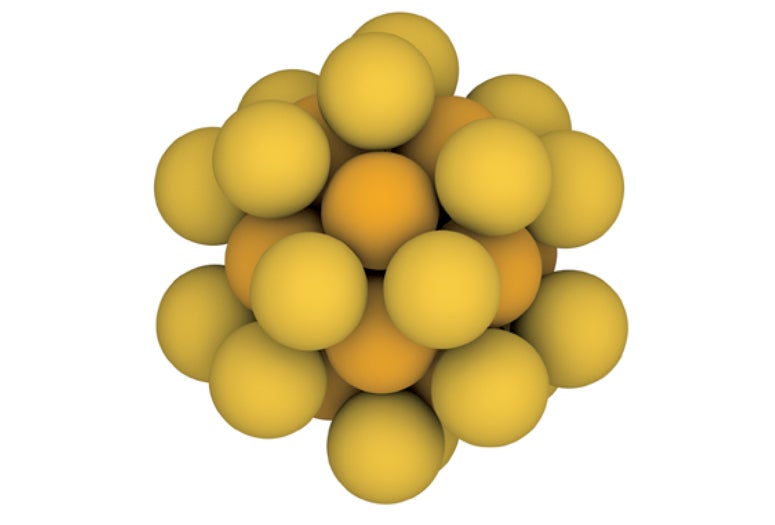Rice University chemists have discovered that tiny gold “seed” particles, a key ingredient in one of the most common nanoparticle recipes, are one and the same as gold buckyballs, 32-atom spherical molecules that are cousins of the carbon buckyballs discovered at Rice in 1985.
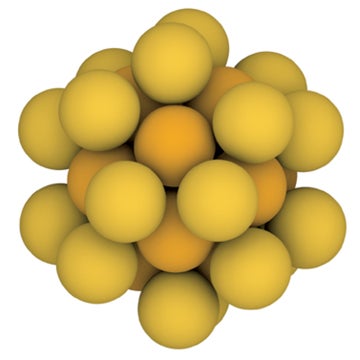
Carbon buckyballs are hollow 60-atom molecules that were co-discovered and named by the late Rice chemist Richard Smalley. He dubbed them “buckminsterfullerenes” because their atomic structure reminded him of architect Buckminster Fuller’s geodesic domes, and the “fullerene” family has grown to include dozens of hollow molecules.
In 2019, Rice chemists Matthew Jones and Liang Qiao discovered that golden fullerenes are the gold “seed” particles chemists have long used to make gold nanoparticles. The find came just a few months after the first reported synthesis of gold buckyballs, and it revealed chemists had unknowingly been using the golden molecules for decades.
“What we're talking about is, arguably, the most ubiquitous method for generating any nanomaterial,” Jones said. “And the reason is that it’s just so incredibly simple. You don’t need specialized equipment for this. High school students can do it.”
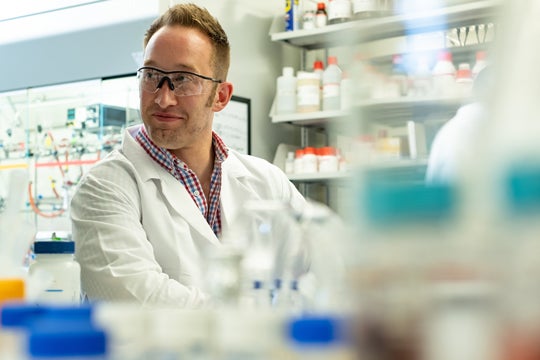
Jones, Qiao and co-authors from Rice, Johns Hopkins University, George Mason University and Princeton University spent years compiling evidence to verify the discovery and recently published their results in Nature Communications.
Jones, an assistant professor in chemistry and materials science and nanoengineering at Rice, said the knowledge that gold nanoparticles are synthesized from molecules could help chemists uncover the mechanisms of those syntheses.
“That’s the big picture for why this work is important,” he said.
Jones said researchers discovered in the early 2000s how to use gold seed particles in chemical syntheses that produced many shapes of gold nanoparticles, including rods, cubes and pyramids.
“It's really appealing to be able to control particle shape, because that changes many of the properties,” Jones said. “This is the synthesis that almost everyone uses. It’s been used for 20 years, and for that whole period of time, these seeds were simply described as ‘particles.’”
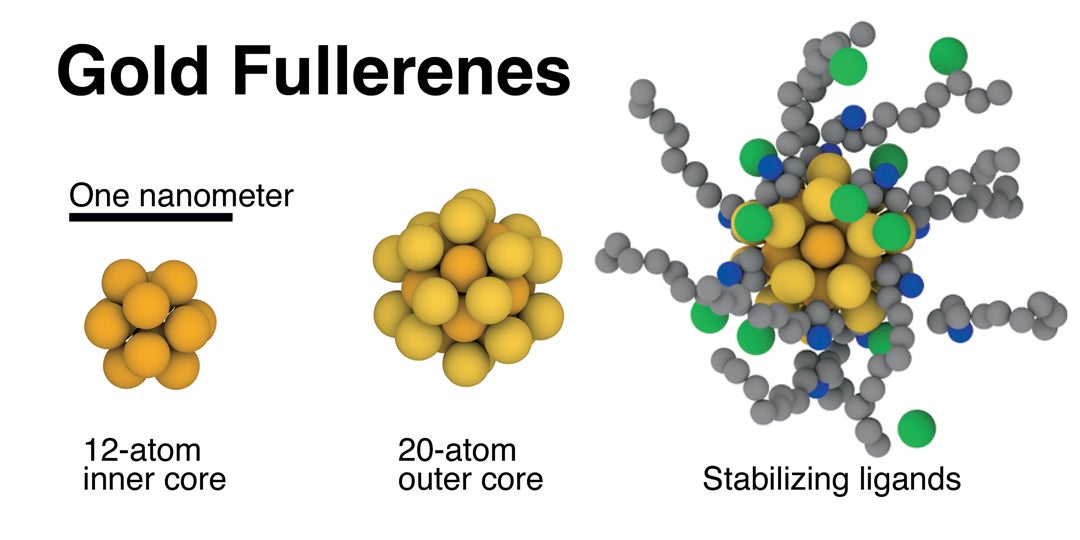
Jones and Qiao, a former postdoctoral researcher in Jones’ lab, weren’t looking for gold-32 in 2019, but they noticed it in mass spectrometry readings. The discovery of carbon-60 buckyballs happened in a similar way. And the coincidences don’t stop there. Jones is the Norman and Gene Hackerman Assistant Professor in Chemistry at Rice. Smalley, who shared the 1996 Nobel Prize in Chemistry with Rice’s Robert Curl and the United Kingdom’s Harold Kroto, was a Hackerman chair in chemistry at Rice for many years prior to his death in 2005.
Confirming that the widely used seeds were gold-32 molecules rather than nanoparticles took years of effort, including state-of-the-art imaging by Yimo Han’s research group at Rice and detailed theoretical analyses by the groups of both Rigoberto Hernandez at Johns Hopkins and Andre Clayborne at George Mason.
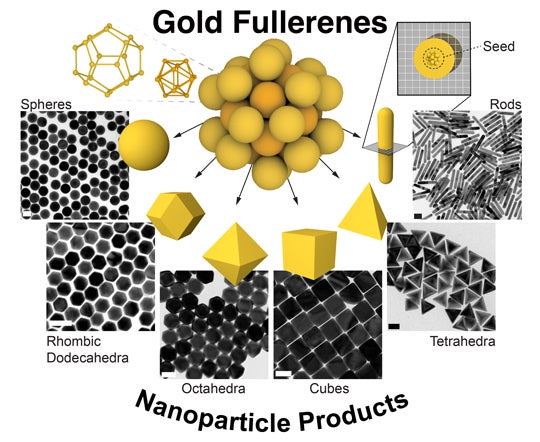
Jones said the distinction between nanoparticle and molecule is important and a key to understanding the study’s potential impact.
“Nanoparticles are typically similar in size and shape, but they are not identical,” Jones said. “If I make a batch of 7-nanometer spherical gold nanoparticles, some of them will have exactly 10,000 atoms, but others might have 10,023 or 9,092.
“Molecules, on the other hand, are perfect,” he said. “I can write out a formula for a molecule. I can draw a molecule. And if I make a solution of molecules, they are all exactly the same in the number, type and connectivity of their atoms.”
Jones said nanoscientists have learned how to synthesize many useful nanoparticles, but progress has often come via trial and error because “there is virtually no mechanistic understanding” of their synthesis.
“The problem here is pretty straightforward,” he said. “It’s like saying, ‘I want you to bake me a cake, and I'm gonna give you a bunch of white powders, but I'm not going to tell you what they are.’ Even if you have a recipe, if you don't know what the starting materials are, it’s a nightmare to figure out what ingredients are doing what.
“I want nanoscience to be like organic chemistry, where you can make essentially whatever you want, with whatever properties you want,” Jones said.
He said organic chemists have exquisite control over matter “because chemists before them did incredibly detailed mechanistic work to understand all of the precise ways in which those reactions operate. We are very, very far from that in nanoscience, but the only way we’ll ever get there is by doing work like this and understanding, mechanistically, what we’re starting with and how things form. That’s the ultimate goal.”
The research was supported by the Welch Foundation (C-1954, C-2065), the Packard Foundation (2018-68049), the National Science Foundation (2145500, 1842494, 2001611, 090079, 1920103, 1625039, 2018631, 2011750) and Rice University.
- Peer-reviewed paper
-
“Atomically precise nanoclusters predominantly seed gold nanoparticle syntheses” | Nature Communications | DOI: 10.1038/s41467-023-40016-3
Authors: Liang Qiao, Nia Pollard, Ravithree D. Senanayake, Zhi Yang, Minjung Kim, Arzeena S. Ali, Minh Tam Hoang, Nan Yao, Yimo Han, Rigoberto Hernandez, Andre Z. Clayborne and Matthew R. Jones
- Video
-
https://youtube.com/shorts/ByDN9AAMUwY
DESCRIPTION: Molecular dynamic simulations revealed that the structural stability of "gold buckyballs," fullerene molecules that each contain 32 gold atoms (yellow), is enhanced by a surrounding halo of organic molecules called ligands (green, blue and gray). (Video courtesy of the Jones Lab/Rice University) - Image downloads
-
https://news-network.rice.edu/news/files/2023/08/0807_GOLD-3p-lg.jpg
CAPTION: Gold buckyball fullerenes each contain a hollow inner core of 12 gold atoms (left) and a 20-atom gold outer core (center). Attached organic ligands (right) stabilize the structure. (Figure courtesy of Jones lab/Rice University)https://news-network.rice.edu/news/files/2023/08/0807_GOLD-F1-lg.jpg
CAPTION: Chemists in Matthew Jones’ lab at Rice University discovered that gold fullerenes (center) are one and the same as “seed” particles (top right) that scientists have long used to synthesize myriad shapes and sizes of gold nanoparticles (left, right and bottom). Each fullerene seed contains 32 atoms of gold arranged in a 12-atom, icosahedral inner core (top left) and a 20-atom dodecahedral outer core (top far left). (Figure courtesy of Jones lab/Rice University)https://news-network.rice.edu/news/files/2023/08/0807_GOLD-mj21fit-lg.jpg
CAPTION: Matthew Jones is the Norman and Gene Hackerman Assistant Professor in Chemistry and an assistant professor of materials science and nanoengineering at Rice University. (Photo by Jeff Fitlow/Rice University)https://news-network.rice.edu/news/files/2023/08/0807_GOLD-Au32-lg.jpg
CAPTION: Rice University chemists discovered that 32-atom gold fullerene molecules are one and the same as “seed” particles scientists have long used to synthesize myriad shapes and sizes of gold nanoparticles. (Figure courtesy of Jones lab/Rice University) - Related stories
-
Tetrahedrons assemble! Three-sided pyramids form 2D structures – July 25, 2022
https://news.rice.edu/news/2022/tetrahedrons-assemble-three-sided-pyramids-form-2d-structuresMatthew Jones wins NSF CAREER Award – Feb. 3, 2022
https://news.rice.edu/news/2022/matthew-jones-wins-nsf-career-awardThis pyramid scheme could be helpful – Oct. 22, 2021
https://news.rice.edu/news/2021/pyramid-scheme-could-be-helpful - Links
-
Jones Research Group: joneslab.rice.edu
Department of Chemistry: chemistry.rice.edu
Department of Materials Science and NanoEngineering: msne.rice.edu
- About Rice
-
Located on a 300-acre forested campus in Houston, Rice University is consistently ranked among the nation’s top 20 universities by U.S. News & World Report. Rice has highly respected schools of Architecture, Business, Continuing Studies, Engineering, Humanities, Music, Natural Sciences and Social Sciences and is home to the Baker Institute for Public Policy. With 4,240 undergraduates and 3,972 graduate students, Rice’s undergraduate student-to-faculty ratio is just under 6-to-1. Its residential college system builds close-knit communities and lifelong friendships, just one reason why Rice is ranked No. 1 for lots of race/class interaction and No. 4 for quality of life by the Princeton Review. Rice is also rated as a best value among private universities by Kiplinger’s Personal Finance.

